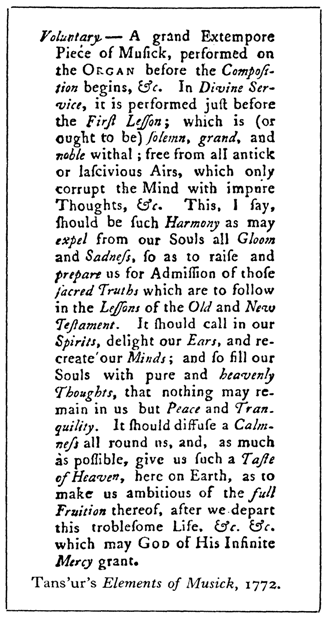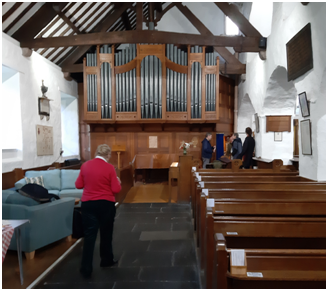
 |
Cumbrian Society of Organists |
Six CSO members assembled at St. Oswald’s Parish Church, Grasmere for an informative and enjoyable afternoon exploring the topic of The Voluntary. Members were privileged to inspect, hear and play the 3 manual organ, originally by Binns and restored earlier this year by Nicholsons.
The course was led by our Chairman, Ian Hare, who is the Director of Music at the church. Ian gave a detailed presentation on the history and development of the voluntary interspersed with a variety of musical examples. Ian introduced the topic with a quotation from Tans’ur’s Elements of Musick, 1772, an early definition of the Voluntary in relation to divine services. Listeners were somewhat taken aback by the very high expectations of the organist contained therein!

Ian pointed out that pre 19th century [English] organ music was mostly for manuals only and much of it is relatively straightforward to play. He discussed ways of interpreting and registering music of various styles on the average parish church organ.
Choosing appropriate music to match the liturgical season and the bible readings for the day was also covered and Ian recommended consulting the weekly suggestions for hymns and voluntaries available in the RSCM’s Sunday by Sunday publications. Various opportunities arise for meditative music during services as well as before and after. There was at one time a custom for a Middle Voluntary and some churches revived this during COVID restrictions when no singing was permitted. Such ideas could still be relevant in smaller churches where there is no choir.
The use of arrangements of popular classics and modern songs was referred to, particularly in the context of weddings and funerals. We will have all come across the comment “Why can’t you play something we know?” or similar. Ian proceeded to play W.T. Best’s arrangement of the Adagio from Beethoven’s Moonlight Sonata to illustrate this. In recent years many new pieces based on hymn tunes familiar to British congregations have been published by Oxford University Press and others.


Following tea and biscuits, kindly provided by church members, three participants played and discussed their own choices of voluntaries. Marjorie Harrison, Samuel Carradice and David T. Shingler played music by Bach, Somervell, Titelouze, and a Prelude and Fugue on Ave Maris Stella composed by Adrian Self. Ian gave helpful hints and comments on registration and performance which were useful both for performers and observers.
Musical illustrations:
Voluntary in D, William Croft (1678-1727)
Prelude on an old Irish church melody, Charles Villiers Stanford (1852-1924)
Fancy, Thomas Tomkins (1572-1656)
Voluntary in G, John Stanley (1712-1786)
Plein chant du premier Kyrie en Taille, François Couperin (1668-1733)
Adagio (from ‘Moonlight’ Sonata), Ludwig van Beethoven (1770-1827)
Chorale Prelude on ‘Jesus Christus, unser Heiland’, J. S. Bach (1685-1750)
Voluntary in D, George Dyson (1883-1964)
National Pipe Organ Register Links